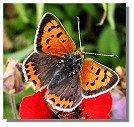
Graphics via Wikimedia
Butterflies of Scotland
- Small Blue (Cupido minimus)

Also known as the 'Little Blue' the Small Blue is rare and localised. It is found in Scotland mainly along the coast of the Moray Firth and on the far north of Caithness.
Britain's smallest resident Butterfly and, despite its common name, not particularly blue. The male has some bluish suffusion at the base of is upperwings but is mostly dark brown like the female. The undersides are a silvery grey with small black dots. The male has a bluish tint at the base of his wings similar to the upperside. Undersides are dull blue-gray colour with small dark spots again with a hint of blue extending from the body.
The sole larval food plant is Kidney Vetch Anthyllis vulneraria. Eggs are laid singly on young flower heads and the larvae feed on the flower heads and developing seeds. They are cannibalistic and will eat any smaller larvae they come across. Fortunately, females will rarely lay eggs on a flower head where one is already present. The fully grown larvae are a pale cream colour and are well camouflaged as they sit on the developing seed heads. In the Autumn they descend and hibernate in crevices in the ground. Pupation occurs the following spring at ground level in the leaf litter. In the south of England there are two broods, one on the wing in June and a second in August, but further north there is just one brood flying in June.
Males are highly territorial selecting a prominent perch in a sheltered position. The females tend to disperse to lay eggs on the buds and flowers of the larval food plant Kidney Vetch. Males and females are often found in communal roosts during the early evening as the sun begins to set.
The Small Blue is a Priority Species for conservation due to the continued loss of habitat and resulting drop in population. The main requirements of the Small Blue are dry sheltered areas of grassland where Kidney Vetch grows. Sites must have sparse or eroding vegetation with bare ground where Kidney Vetch seedlings can become established and where flowering Kidney Vetch is abundant.
Return to the Butterfly Index
or go to the next Butterfly:  Small Copper.
Small Copper.
Where else would you like to go in Scotland?

